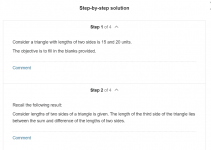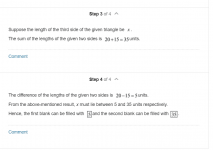- TS TS
- #41
Patulong boss. Thanks in advance.
You do not have permission to view the full content of this post. Log in or register now.
Attachments
-
You do not have permission to view the full content of this post. Log in or register now.
Patulong boss. Thanks in advance.
You do not have permission to view the full content of this post. Log in or register now.
pa help po boss
You do not have permission to view the full content of this post. Log in or register now.
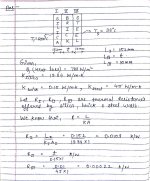
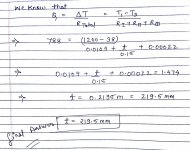



Solution:Pa unlock po sana ako
You do not have permission to view the full content of this post. Log in or register now.
Salamat po ng maramiSolution:
Reorder point =12
Subtotal = Par stock - Reorder Point = 42 - 12 = 30
Reorder quantity = Subtotal + Normal Usage = 30 + 21 = 51
Thus, reorder point is 12 and reorder quantity is 51.

Sol :-You do not have permission to view the full content of this post. Log in or register now.
pa help po salamat!
| MnO4- + 5VO2+ + 11H2O ------------> Mn2+ + 5V(OH)4+ + 2H+ |
| I2 + H2S ------------> 2I- + S + 2H+ |
| Cr2O72- + 2H+ + 3U4+ ------> 2Cr3+ + 3UO22+ + H2O |
| 2Cl- + MnO2 + 4H+ ------------> Cl2 + Mn2+ + 2H2O |
| HPO32- + 2MnO4- + 3OH- -----------> PO43- + 2MnO42- + 2H2O |
salamat po!Sol :-
Use the steps :
Step.1 :- Balance the oxidation and reduction half cell reactions separately.
Step.2 :- Balance the atoms other than hydrogen and oxygen first.
Step.3 :- Balance the O atom by adding suitable number of H2O.
Step.4 :- Balance the hydrogen atom by adding suitable number of H+ .
Step.5 :- Balance the charge on both side by adding suitable number of electrons.
(a). Oxidation half cell reaction is :
VO2+ + 3H2O ------------> V(OH)4+ + 2H+ + 1e-
Reduction half cell reaction is :
MnO4- + 8H+ + 5e-------------> Mn2+ + 4H2O
Multiply oxidation half by 5 and then add both half cells, So
Balanced redox reaction in acidic medium is :
Oxidizing agent = MnO4-
MnO4- + 5VO2+ + 11H2O ------------> Mn2+ + 5V(OH)4+ + 2H+
and
Reducing agent = VO2+
(b).
Oxidation half cell reaction is :
H2S ------------> S + 2H+ + 2e-
Reduction half cell reaction is :
I2 + 2e- ------------> 2I-
Add both half cells, So
Balanced redox reaction in acidic medium is :
Oxidizing agent = I2
I2 + H2S ------------> 2I- + S + 2H+
and
Reducing agent = H2S
(c).
Oxidation half cell reaction is :
U4+ + 2H2O ------------> UO22+ + 4H+ + 2e-
Reduction half cell reaction is :
Cr2O72- + 14H+ + 6e- ------------> 2Cr3+ + 7H2O
Multiply oxidation half by 3 and then add both half cells, So
Balanced redox reaction in acidic medium is :
Oxidizing agent = Cr2O72-
Cr2O72- + 2H+ + 3U4+ ------> 2Cr3+ + 3UO22+ + H2O
and
Reducing agent = U4+
(d).
Oxidation half cell reaction is :
2Cl- -------------> Cl2 + 2e-
Reduction half cell reaction is :
MnO2 + 4H+ + 2e- -------------> Mn2+ + 2H2O
Add both half cells, So
Balanced redox reaction in acidic medium is :
Oxidizing agent = MnO2
2Cl- + MnO2 + 4H+ ------------> Cl2 + Mn2+ + 2H2O
and
Reducing agent = Cl-
(g).
Oxidation half cell reaction is :
HPO32- + H2O -------------> PO43- + 3H+ + 2e-
Reduction half cell reaction is :
MnO4- + 1e- -------------> MnO42-
Multiply reduction half by 2 and then add both half cells, So
Balanced redox reaction in acidic medium is :
HPO32- + 2MnO4- + H2O -----------> PO43- + 2MnO42- + 3H+
Add 3OH- on both the sides, So
Balanced redox reaction in basic medium is :
Oxidizing agent = MnO4-
HPO32- + 2MnO4- + 3OH- -----------> PO43- + 2MnO42- + 2H2O
and
Reducing agent = HPO32-
4) Acute pain related to abdominal mass as evidenced by pain score.Boss pa unlock po nung answer salamat po You do not have permission to view the full content of this post. Log in or register now.
Salamat ng marami boss Godbless po4) Acute pain related to abdominal mass as evidenced by pain score.
6) In checklist we have to mention medication received pre-operative wth dose and time of administration.
7) as atropine is give watch fr heart rate
8)International patient goal are: identification of pt ( by name band and asking pts his name )
-Improve effective communication
-Improve the safety of HR medication
-Ensure safe surgery
-Reduce hospital acquired infection
SURGICAL SAFETY CHECKLIST:
Ward staff ll shift the pt to recovery room where the recovery nurse ll indentifu pt by his band and confirming him by asking his name, consultant name and sx plannef for him, from when he is nbm, did sx siye marking is there or nt. Then technician , circulatory nurse ll take the pt to ot room . There circultory nurse ll again ask the pt name , age ,cinsultant name and sx bame planned for . Anesthetic ll do the same . time in ,timeout n sign out time ll be mention.
PACU NURSE :9) should watch for is pt is drowsy, pain, after he is awake .
10)oxygenation requirement as pt has h/o copd no oxygen is give insted we can give air by neb mask or face mask.
11)SURGEON NEED TO KNOW:
- his vitals
-drain output
Urine output
Oozing from surgical site
12) sacrum, heels ,elbow
13) monitor glucose,saturation, drain output , mobilzation, administration of pain medication.
14) pt is responsible fr his recovery by following nurses request n instead of pain he does early mobilization, taking medicine and taking rest as well.
15) pt need emotinal support. provide psychological support by encouraging him giving postive attitude comfort.
17) we ll inform to junior consultant about the drain and if says to change we ll go ahead if no so can't do anything.
18) When did pts had his last meal we need to check it first . and after doing the procedure nt to attached on suction port again
19) IS ll expand the lung n facilitate the breathing.
20) hemorrage as pt undergone for sx surgical site is at risk till it heal .
Abdominal distention bcz of sx pt may have pain while passing stool so it can happen

1st link :Hello. Kindly unlock these for me:
You do not have permission to view the full content of this post. Log in or register now.
You do not have permission to view the full content of this post. Log in or register now.
You do not have permission to view the full content of this post. Log in or register now.
You do not have permission to view the full content of this post. Log in or register now.
You do not have permission to view the full content of this post. Log in or register now.
Thank you in advance!
Thank you!1st link :
What is the molar solubility of PbCl2 in a solution containing 0.020 M Cl-(aq)? The Ksp for PbCl2 is 1.6x10-5 ?
ksp(PbCl2)=Pb2+ + 2Cl1-
ksp=[Pb2+][Cl1-]2
solubility in pure water
ksp=s*(2s)2=4s3
s=(ksp/4)0.333=(1.6/4x10-5)0.333=0.01594moles/L
now solubility of lead chloride containing 0.02M Cl1- ions is as
Pb2+=ksp/[Cl1-]2=(1.6x10-5)/(0.02)2=0.04M
2nd link:
View attachment 1513843
3rd link:
View attachment 1513844
4th link:
Answer (16)
(C) 3
Answer (17)
t-butoxide can be used to form the “less substituted” alkenes in elimination reactions (the E2, specifically).
(d) KOtBu
Answer (18)
Stability of Radicals. Due to the unpaired electrons, free radicals do not have an electron octet. Therefore, they are usually instable and highly reactive. As a result of their high reactivity, radicals merely show a low selectivity.
(C) 2 > 3 > 1
5th link:
View attachment 1513845
1:Hello. Kindly unlock these for me:
You do not have permission to view the full content of this post. Log in or register now.
You do not have permission to view the full content of this post. Log in or register now.
You do not have permission to view the full content of this post. Log in or register now.
You do not have permission to view the full content of this post. Log in or register now.
You do not have permission to view the full content of this post. Log in or register now.
Thank you in advance!
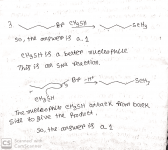
You do not have permission to view the full content of this post. Log in or register now.
Pahelp po ulit. Thankssss
